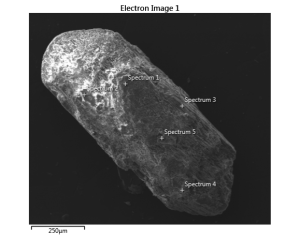During the summer holidays I completed a five-week Nuffield Research Placement. This took place at the Open University in the School of Environment, Earth and Ecosystem Sciences (EEES).
My project was to assist in exploring the nature of gypsum crystals found in deep-sea sediments from monsoon region.

A microscope view of gypsum crystals.
My aims were to:
- Investigate ocean sediments;
- Identify crystals (quartz or something else?) and other marine, terrestrial and minerals formed during the sediment deposition, using a binocular microscope;
- Determine the relative abundance of crystals with respect to other known fragments, such as pyrite and biogenic components;
- Evaluate environmental changes related to physical weathering or any other processes operating during the sediment deposition.
This was all to help answer two related questions: 1) how were these crystals formed; and 2) what conditions were needed?
During the first week of my placement I familiarised myself with different components in the sediment, such as crystal (quartz), pyrite, silica shells, foraminifera shells and, crucially, how to use the microscope.
At first, I used a reference slide to make sure I was classifying the material in the right categories. After a while I found that I became better at noticing certain characteristics.
During the placement, I counted 62 samples that were chosen from one of the monsoon sites (core 29X-32X). This meant that I counted somewhere between 400 to 600+ grains.

A scanning electron microscope image of a gypsum crystal.
If the sample was too big I had to divide them, or they would be too difficult and time consuming to count. This took the majority of my time.
After I finished counting the samples I began the process of analysing the data. This part was complicated and challenging at times, but rewarding. I drew some interesting conclusions from the analysed data which made the time spent staring at ‘excel for dummies’ worthwhile.

A spectrum of chemical elements revealing that a crystal was not quartz but gypsum.
The final weeks of my project were spent creating my project report and poster. It was interesting to learn how scientific reports are written and I am sure it is a skill I will be needing in the future.
Throughout my project, I learnt a lot of new skills and information about science, discovering different aspects of science than I am used to. I read books and scientific reports about monsoons and gypsum formation, so I could be better informed and draw more solid conclusions.
I also needed a lot of assistance from specialists at the university to really help to understand the data and give me more insight on the topic.
I would specially like to thank my project provider and mentor Dr Pallavi Anand at the Open University and the Nuffield Foundation for providing me the opportunity to conduct this research. Special thanks also go to Yasmin Bokhari-Friberg for her help with information on Monsoon and her PhD project.
This experience has broadened my knowledge and deepened my interest in scientific research. There is still so much to be uncovered and I can’t wait to discover more and conduct more extensive research myself. Overall, this experience has been invaluable.

